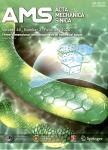Study on the damage-softening constitutive model of rock and experimental verification
作者机构:State Key Laboratory for Geomechanics and Deep Underground Engineering School of Mechanics and Civil Engineering China University of Mining and Technology Xuzhou 221116 China China Construction Third Engineering Design Bureau Co. Ltd Wuhan 430064 China
出 版 物:《Acta Mechanica Sinica》 (力学学报(英文版))
年 卷 期:2019年第35卷第4期
页 面:786-798页
核心收录:
学科分类:08[工学] 0801[工学-力学(可授工学、理学学位)]
基 金:This research was supported by the National Natural Science Foundation of China (Grants 51734009 & 51179189) the Fifth “333” Project of Jiangsu Province (2016) the China Postdoctoral Science Foundation (Grant 2018M642360) The authors would like to express their sincere gratitude to the editor and two anonymous reviewers for their valuable comments which have greatly improved this paper
主 题:Rock deformation Damage evolution Softening Numerical calculation
摘 要:A damage-softening model is presented to describe the stress-strain curve of rock. By comparing the Hoek-Brown (H-B) and Mohr-Coulomb (M-C) yield criterion, the equivalent M-C yield criterion is selected as the strength criterion in this model. To better characterize the rock damage and failure processes with considering the relationship between damage and deformation, the concept of yield stress ratio is introduced to describe the yield strengthening deformation before rock peak stress. Damage events are described by two cumulative damage evolution laws. The evolution equations of tensile and shear damage are presented based on the equivalent plastic strains and the maximum value between tensile and shear damage represents the total damage for rock. Considering that rock cannot bear tensile load after tensile failure but still has a certain shear strength, its tensile and shear strengths are small after shear failure. The elastic modulus is affected by tensile damage, whereas the angle of internal friction, the cohesion, and dilation angles are influenced by shear damage. The proposed damage-softening model describes the strain-softening, brittle stress-drop, and residual strength of rock after peak stress, and finally the model is implemented in FLAC3D. Comparing the test and the numerical calculation results, the damage-softening model better describes the total stress-strain curve of rock.



